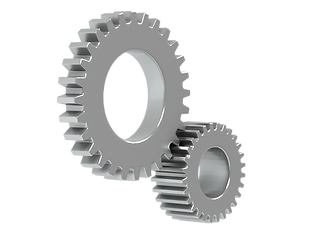

Gear Activities
We have developed a series of gears activities for introducing middle-school students to constant ratios and rates of change. These activities are designed to help students begin to form ratios and develop the idea of constant rates of change.
Feel free to use them in your own classroom!
Why Are Gears Good for Linear Functions?
Gear ratios make a good context for linear functions for 5 reasons:
-
Students can directly explore the situation. With physical gears, students can investigate what happens when turning gears a certain number of times. As students begin to develop conclusions and create generalizations, direct exploration will grow less important over time.
-
The situation is not contrived to be linear, but is naturally linear. In many situations in textbooks, data are merely presented as linear even if that is unlikely to be the case in real life. For example, a situation comparing the number of boogie boards sold on a given day to the temperature that day might be presented to students in terms of linear data points, but would probably not be linear in real life. The contrived nature of situations like that can conflict with students’ natural sense-making and can be confusing to students. In contrast, the linearity in gear ratios is inherent in the situation.
-
The situation is exactly rather than approximately linear. Other common situations, such as speed or heart rates, either involve data that are only approximately linear or force data to be linear (for instance, by assuming that somebody walks a constant speed). The ratio of the rotations of gears is exactly linear, which means there are no measurement error problems. Messy situations that are approximately linear can be good contexts for helping students understand the power of mathematics as a modeling tool, but those are best saved for times when students already understand linearity, rather than as a way to introduce linearity for the first time.
-
The relationship is dynamic rather than static. Say you’re comparing the weight of a pile of pennies to the number of pennies in the pile. In this situation, the relationship is linear, but it is hard to think about the pile of pennies as something that changes through time in relationship to the weight of the pile. Although you can construct an equivalence class of ratios, it might be hard to imagine part of a penny. There are also some situations, such as a heart rate, that you can imagine continuing through time but cannot partition in every way possible. it is hard to imagine a “part” of a beat when comparing the number of heartbeats to the number of seconds. With gears, students can easily imagine a part of a revolution.
-
Students can investigate why. Gear ratios provide students opportunities to prove. Other situations might be difficult to understanding why a given relationship is linear in the first place. For example, one textbook activity introduces linearity by comparing the number of layers of a paper bridge to the number of pennies it can hold. It is not clear to algebra students why this relationship would necessarily be linear as opposed to something else. In contrast, gear ratios allows students to create justifications for why the ratio between the revolutions of two gears must remain constant.